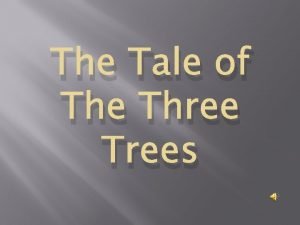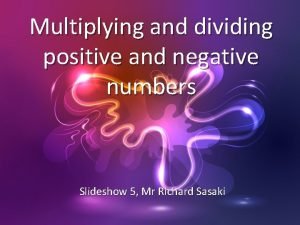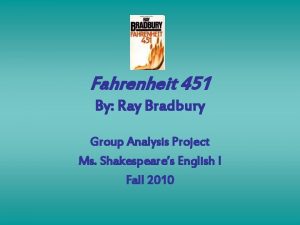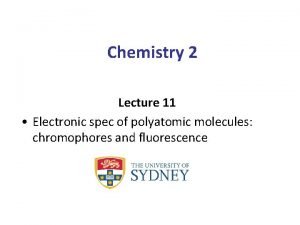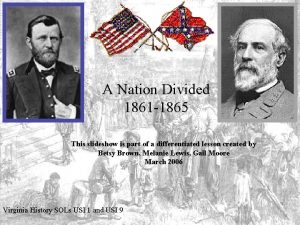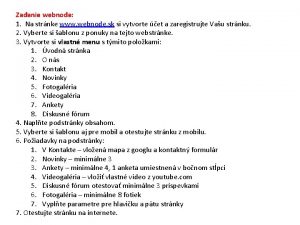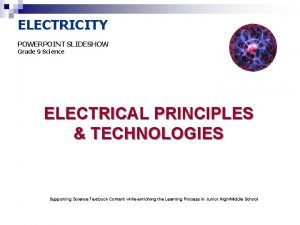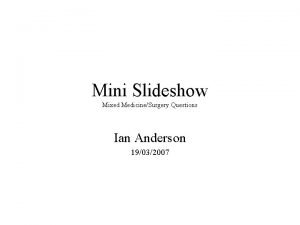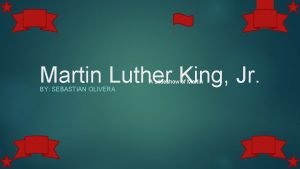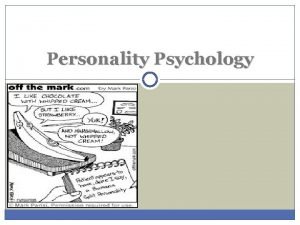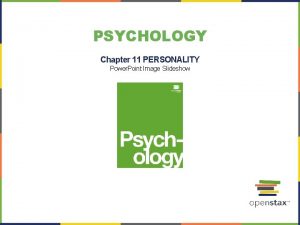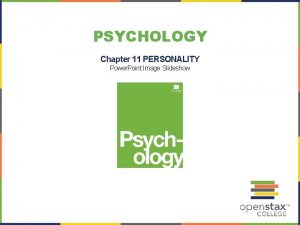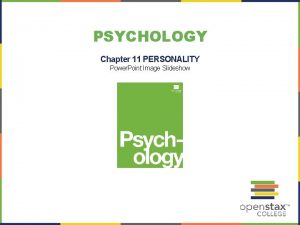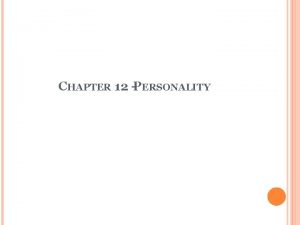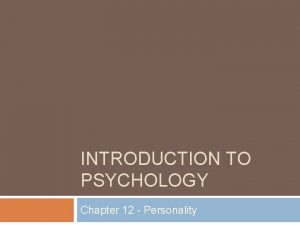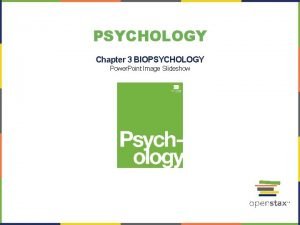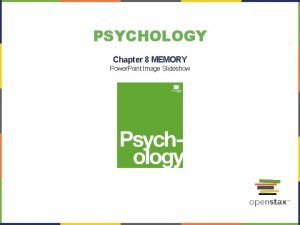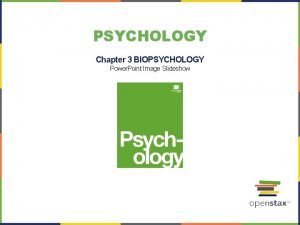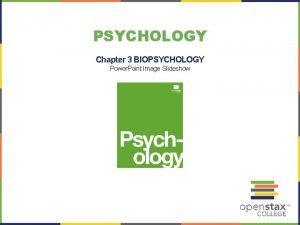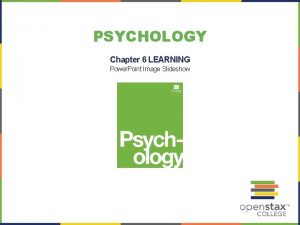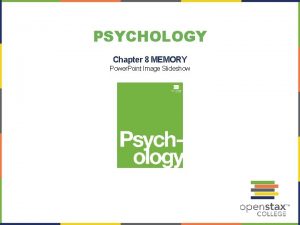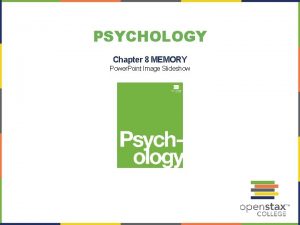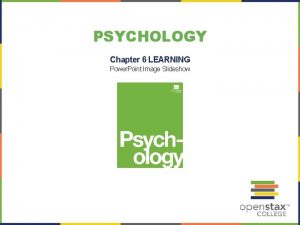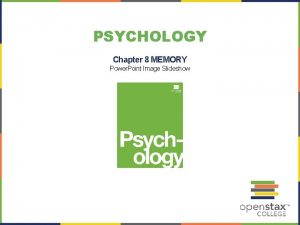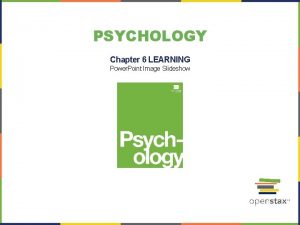PSYCHOLOGY Chapter 11 PERSONALITY Power Point Image Slideshow


























- Slides: 26

PSYCHOLOGY Chapter 11 PERSONALITY Power. Point Image Slideshow

FIGURE 11. 1 What makes two individuals have different personalities? (credit: modification of work by Nicolas Alejandro)

DEFINITION OF PERSONALITY Personality: • Sum of all of the ways of acting, thinking and feeling that are typical for a person makes each person different from other individuals

TRAIT THEORY Allport’s trait theory: - most important traits are those related to our values - cardinal - central - secondary

TRAIT THEORY (CONT. ) Five-factor model of personality

TRAIT THEORY (CONT. ) Validation of personality traits: • Hans Eysenck: • introversion • extroversion

PSYCHOANALYTIC THEORY: SIGMUND FREUD Freud’s mind: - 3 levels of consciousness: • • • conscious mind preconscious mind unconscious mind: repression

PSYCHOANALYTIC THEORY: SIGMUND FREUD (CONT. ) Freud’s Mind: id, ego and superego • id: • pleasure principle • primary process thinking • ego: • reality principle • superego: • conscience • ego ideal

FIGURE 11. 6 The job of the ego, or self, is to balance the aggressive/pleasure-seeking drives of the id with the moral control of the superego.

FIGURE 11. 7 Defense mechanisms are unconscious protective behaviors that work to reduce anxiety.

PSYCHOANALYTIC THEORY: SIGMUND FREUD (CONT. ) Growing up: the stages of psychosexual development - developmental stages result from a shifting of the primary outlet of libido energy of the id from one part of the body to another • erogenous zones

PSYCHOANALYTIC THEORY: SIGMUND FREUD (CONT. ) Oral stage: (birth to 1 year) • oral dependent personality: seeks pleasure by overeating, smoking and by being a gullible person • oral aggressive personality: seeks pleasure by being verbally hostile to others

PSYCHOANALYTIC THEORY: SIGMUND FREUD (CONT. ) Anal stage: (1 to 3 years) • toilet training children learn how much control they can exert over others with their anal sphincter muscles • anal retentive • anal expulsive

PSYCHOANALYTIC THEORY: SIGMUND FREUD (CONT. ) Phallic stage: (3 to 6 years) - genitals become primary source of pleasure - Oedipus complex: castration anxiety - Electra complex: penis envy - Phallic personality

PSYCHOANALYTIC THEORY: SIGMUND FREUD (CONT. ) Latency stage: (6 to 11 years) • Sexual interest is relatively inactive • Sexual desire has been strongly repressed through the resolution of the Oedipal or Electra complex • Sexual energy is sublimated into competence in schoolwork, play and sports

PSYCHOANALYTIC THEORY: SIGMUND FREUD (CONT. ) Genital stage (11 years on): • Sexual pleasure through the genitals arrival of puberty • Masturbation • Sexual and romantic interest in others is central motive

PSYCHOANALYTIC THEORY: SIGMUND FREUD (CONT. ) Theories derived from psychoanalysis: • Carl Jung: • Extraversion and introversion • Personal unconscious • Collective unconscious

SOCIAL LEARNING THEORY: ALBERT BANDURA Role of learning in personality : -Reciprocal determination: • Behavior is learned and the social learning environment is altered by the behavior

FIGURE 11. 10 Bandura proposed the idea of reciprocal determinism: Our behavior, cognitive processes, and situational context all influence each other.

SOCIAL LEARNING THEORY: ALBERT BANDURA (CONT. ) Role of cognition in personality: • Self-efficacy: • Perception that one is capable of doing what is necessary to reach one’s goals • Self-regulation: • Personal standards for one's behavior from observing the personal standards that other people model

SOCIAL LEARNING THEORY: ALBERT BANDURA (CONT. ) Situationism and interactionism: • Behavior is determined by the situations in which people find themselves, not traits inside the person • Person X situation interactionism: different people react to the same situation differently

HUMANISTIC THEORY: MASLOW AND ROGERS Inner-directedness and subjectivity: • Inner-directedness: • Internal force that pushes one to become the best individual he/she is capable of being • Subjective reality: • Viewing life in different, highly personal terms

HUMANISTIC THEORY: MASLOW AND ROGERS (CONT. ) Self-concept: • Carl Rogers: • Self • Ideal self: • Congruency

HUMANISTIC THEORY: MASLOW AND ROGERS (CONT. ) Humanism compared with classic psychoanalysis and social learning theory: all three theories believe that one internalizes society’s standards of what is desirable/moral and guides his/her behavior accordingly.

PERSONALITY ASSESSMENT Interviews and observational methods: • Interviews: • Most widely used method • Asking questions • Observations: • Observing a person’s actual behavior in a natural or simulated situation

PERSONALITY ASSESSMENT (CONT. ) Projective personality tests: • Unconscious feelings will be “projected” into the interpretation • Thematic Apperception Test (TAT) • Rorschach inkblot test
 The real lesson 21
The real lesson 21 Power bi training powerpoint
Power bi training powerpoint Point point power
Point point power Tommy's window slideshow prayer
Tommy's window slideshow prayer The tale of 3 trees
The tale of 3 trees Sabbath school powerpoint
Sabbath school powerpoint Naruto slidshow
Naruto slidshow Dust bowl slideshow
Dust bowl slideshow Dividing negative numbers
Dividing negative numbers Chapter 8 lotf
Chapter 8 lotf Fahrenheit 451 plot diagram
Fahrenheit 451 plot diagram Franck-condon principle slideshow
Franck-condon principle slideshow Slideshow
Slideshow Webnode.sk
Webnode.sk Probability slide
Probability slide Anglophonewest.schoolcashonline
Anglophonewest.schoolcashonline Which term is used to describe bitmap images?
Which term is used to describe bitmap images? Electricity powerpoint
Electricity powerpoint Jacob and esau slideshow
Jacob and esau slideshow Colour 19032007
Colour 19032007 Martin luther king jr slideshow
Martin luther king jr slideshow Social facilitation example psychology
Social facilitation example psychology Psychological factors of personality
Psychological factors of personality Nomothetic approach
Nomothetic approach Fixated consumption behavior
Fixated consumption behavior Define personality psychology
Define personality psychology Evocation personality psychology
Evocation personality psychology




